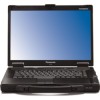Panasonic Toughbook 52 Assessing the Broad Business Case for Rugged Computing - Page 2
Assessing the Broad Business Case for, Rugged Mobile Computing Devices
 |
View all Panasonic Toughbook 52 manuals
Add to My Manuals
Save this manual to your list of manuals |
Page 2 highlights
Assessing The Broad Business Case For Rugged Computing Assessing the Broad Business Case for Rugged Mobile Computing Devices While the concept of rugged computing has been pioneered by users working in extreme environmental conditions, there is growing evidence that a broader business market is developing for this category of mobile computers. The new trend is driven by three factors: • The number of mobile workers as a percentage of the overall workforce is growing; • New broadband wireless technologies (EVDO1 and HSDPA2 and Gobi in particular) increase the opportunities to connect to key information resources from more places and at any time; and • Increased usage of mobile computers in a greater variety of environments exposes these devices to greater risk of physical harm. According to analysts at Boonton, NJ-based Insight Research, employers are now actively promoting the expansion of their mobile workforce, especially as new technology developments enable continuous communication with employees outside of the office. This observation is further supported by a study from the Washington, DC-based Telework Coalition, which found that: • 89 of the top 100 US companies offer telecommuting; • 58 percent of companies consider themselves a virtual workplace; • Only nine percent of employees worked at headquarters; and • 67 percent of all workers used mobile and wireless computing. Workers, in short, are on the move. They are increasingly doing mission-critical work when they are away from the office. While it may have been feasible in the early days of mobility to use dial-up facilities- and later find Wi-Fi hotspots in coffee houses or hotel lobbies- the mainstreaming of mobility creates a new requirement for anytime access. This helps to explain why demand for wireless broadband services is expected to grow at a compounded rate of more than 60 percent through the rest of the decade, while wireline services will grow at only 10 percent over the same forecast horizon, according to Insight analysts. Business users- and a growing number of consumers- find that they cannot afford to wait when they need to connect with colleagues, customers and suppliers. 1 Evolution, Data Only or Evolution, Data Optimized 2 High-Speed Downlink Packet Access Copyright © All Rights Reserved for Larstan Business Reports 2











